Nevada’s state flag once looked different than it does today
For a landlocked state in the desert, Nevada’s flag sure does have a lot of blue. But it’s not about the ocean, it’s about loyalty.
Nevada’s flag has gone through several iterations over the years, and the most recent one, finalized in 1991, represents the many symbols of the Silver State.
Emblazoned on the blue flag in the upper left corner is a silver star — a reference to the state’s nickname based on its mining history — with a golden banner above it with the the words “Battle Born,” a nod to the state’s founding during the Civil War. The blue color symbolizes the state’s loyalty to the union, according to the Nevada Legislature.
Underneath the star is the word “Nevada” in gold, with the state’s flower, the sagebrush, closing off the emblem.
But it didn’t always look like that.
From 1905 to 1915, an early state flag was adorned with a large “NEVADA” in the middle. At the top, the word “SILVER” was emblazoned, and at the bottom was the word “GOLD.” In between the words were 18 gold stars and 18 silver stars to represent the 36th state to join the union.
That early design was recommended by Gov. John Sparks, the 10th governor of Nevada, and a colonel named Sylvester “Henry” Day, an assistant adjutant general of the Nevada National Guard, according to the “Political History of Nevada.”
In 1915, a Nevada historian and Carson City native named Clara M. Crisler, who worked as an enrolling clerk for the Assembly in two legislative sessions, designed a flag that featured a shield from the state seal.
Inside the shield was a railroad, horses pulling a wagon, a mine, a sheaf of white, agricultural tools, and a sun rising over mountains. The slogan “All for our country,” was emblazoned on the flag, as well as “Nevada.” Like the first flag, 18 gold stars and 18 silver stars bordered the shield to represent Nevada’s status as the 36th state.
According to the Legislature, that design was too expensive to produce, and in 1926, a movement to change the flag began when Lt. Gov. Maurice J. Sullivan published notices in Nevada newspapers announcing a contest for a new design, according to the “Political History of Nevada.”
The winner of the contest would get $25, according to the book. In early 1927, the Nevada Legislature appointed members to serve on a committee to select a design, and on Jan. 27, 1927, an assemblyman announced the design by “Don” Louis Schellbach III, an artist for the state highway department.
In 1929 Senate Bill 51 created the state flag, using Schellbach’s design.
His original design, however, did not contain the word “Nevada,” and in the 1929 Legislature, Cada Boak added the word through an amendment approved by the Assembly. It placed “Nevada” in a circle around the star in the flag.
The new flag was not well known, according to the “Political History of Nevada,” so in 1935 the Nevada State Flag Association was formed, and it enlisted the American Legion of the State to provide monetary support and needlewomen to make flags by hand. By 1939, new flags were produced for the governor’s office and the University of Nevada.
There was a clerical error made in 1929 in the flag’s legislation, and the mistake was found in 1989. During the 1991 legislative session, the Nevada Legislature changed the placement of the word “Nevada” on the flag, placing it above the sprays in gold.
Contact Jessica Hill at jehill@reviewjournal.com. Follow @jess_hillyeah on X.

















